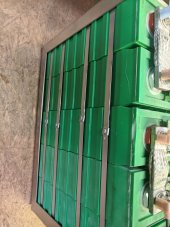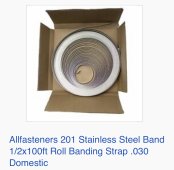I am about to make a 4P16S LifePo4 pack using used tested cells. The cells were in a OEM enclosure in 10S configuration with stainless steel strapping (4 bands) around each group of 5 cells with aluminum plates at each end. I have seen a few other pictures on the net of other plastic cell OEM configurations that also use steel strapping around the cells. 90% of the info here on the forum is about EVE cells, thus my questions.
It would appear that the intent is to prevent expansion more so than compressing the cells. I have read everything I can find on the subject but there just isn't any info out there on steel banding plastic case prismatics.
My present thinking is to follow what the OEM manufacturers did but rather than steel straps use plates with threaded rod similar to the common method with springs, just no springs, snug up the nuts and quit there.
Here is a link to a post here on the forum showing the strap configuration (post #27) by WInston battery : https://diysolarforum.com/threads/c...e-batteries-together.27575/page-2#post-331261
And a picture of one of my battery banks showing the OEM steel straps. There is no info available from the manufacturer, they are out of business. The straps have a crimp where each overlaps with a screw clip to prevent separation. I have taken a over all length measurement of the banded cells as a reference point to use.
What are the thoughts here?? Just use rods, no springs, snug the nuts up and basically duplicate what the OEM's did only with threaded rod instead of strapping? Thinking of tightening just enough to obtain the same overall length as the OEM setup which appears very consistent.
It would appear that the intent is to prevent expansion more so than compressing the cells. I have read everything I can find on the subject but there just isn't any info out there on steel banding plastic case prismatics.
My present thinking is to follow what the OEM manufacturers did but rather than steel straps use plates with threaded rod similar to the common method with springs, just no springs, snug up the nuts and quit there.
Here is a link to a post here on the forum showing the strap configuration (post #27) by WInston battery : https://diysolarforum.com/threads/c...e-batteries-together.27575/page-2#post-331261
And a picture of one of my battery banks showing the OEM steel straps. There is no info available from the manufacturer, they are out of business. The straps have a crimp where each overlaps with a screw clip to prevent separation. I have taken a over all length measurement of the banded cells as a reference point to use.
What are the thoughts here?? Just use rods, no springs, snug the nuts up and basically duplicate what the OEM's did only with threaded rod instead of strapping? Thinking of tightening just enough to obtain the same overall length as the OEM setup which appears very consistent.
Attachments
Last edited:




